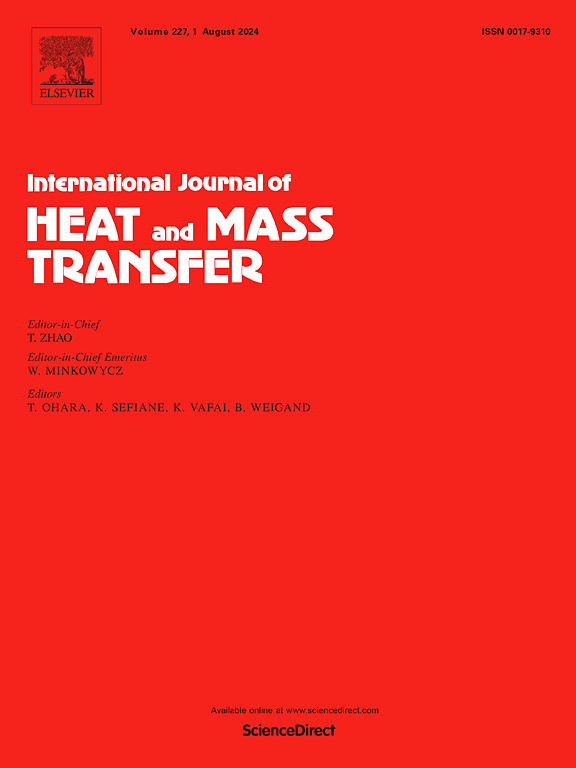Experimental analysis of the start-up characteristics in a pulsating heat pipe with different filling ratios under vertical vibration excitations
IF 5.8
2区 工程技术
Q1 ENGINEERING, MECHANICAL
International Journal of Heat and Mass Transfer
Pub Date : 2025-06-21
DOI:10.1016/j.ijheatmasstransfer.2025.127427
引用次数: 0
Abstract
Pulsating heat pipes (PHPs) are inevitably exposed to external vibration disturbances in practical applications. An in-depth understanding of the start-up behavior of PHPs is critical for improving their thermal responsiveness. This work experimentally examined the effect of vertical vibration amplitudes (0.2–1.0 mm) and frequencies (10–50 Hz) on the start-up performance of a water-based two-turn PHP with varying filling ratios (35–75 %). The start-up process of the PHP was elucidated by analyzing the transient oscillation characteristic of wall temperatures and the motion behavior of vapor-liquid slugs. Furthermore, the capillary hysteresis resistance induced by external vibrations was quantitatively analyzed by tracking the meniscus position and morphology. Results indicate that the start-up time of the PHP increases as the vibration amplitude rises. This is because an asymmetry deformation of menisci causes the difference in the contact angles on both sides of a liquid slug, thereby producing an additional capillary hysteresis resistance that impedes the fluid motion. Moreover, a high filling ratio can mitigate the adverse effect of vibration amplitudes on the start-up time by suppressing the meniscus deformation. Conversely, the start-up time of the PHP shortens as the vibration frequency increases, which is most pronounced under the filling ratio of 55 %. Additionally, the vibration frequency and amplitude exhibit a competing effect. The high-frequency and low-amplitude vibration (50 Hz, 0.2 mm) makes the greatest enhancement in the start-up time, but may increase the start-up temperature at a lower filling ratio of 35 %. Under the vibration conditions of this work, the PHP with a filling ratio of 55 % exhibits the optimal start-up performance. The start-up time and temperature reduced by 20.1 % and 11.0 %, respectively, compared to the non-vibration condition.
垂直振动激励下不同填充率脉动热管启动特性的实验分析
脉动热管在实际应用中不可避免地会受到外界振动干扰。深入了解php的启动行为对于提高其热响应性至关重要。实验研究了垂直振动振幅(0.2-1.0 mm)和频率(10-50 Hz)对不同填充率(35 - 75%)的水基两匝PHP启动性能的影响。通过分析壁面温度的瞬态振荡特性和气液段塞的运动特性,阐明了PHP的启动过程。此外,通过对半月板位置和形态的跟踪,定量分析了外部振动引起的毛细血管迟滞阻力。结果表明,随着振动幅值的增加,PHP的启动时间也随之增加。这是因为半月板的不对称变形导致液体段塞两侧接触角的差异,从而产生额外的毛细滞后阻力,阻碍流体运动。此外,高填充率可以通过抑制半月板变形来减轻振动幅值对启动时间的不利影响。相反,随着振动频率的增加,PHP的启动时间缩短,在填充比为55%时最为明显。此外,振动频率和振幅表现出竞争效应。高频低幅振动(50 Hz, 0.2 mm)对启动时间的增强作用最大,但在较低填充比为35%时可能会使启动温度升高。在本工作的振动条件下,填充率为55%的PHP具有最佳的启动性能。与无振动工况相比,启动时间和温度分别降低了20.1%和11.0%。
本文章由计算机程序翻译,如有差异,请以英文原文为准。
求助全文
约1分钟内获得全文
求助全文
来源期刊
CiteScore
10.30
自引率
13.50%
发文量
1319
审稿时长
41 days
期刊介绍:
International Journal of Heat and Mass Transfer is the vehicle for the exchange of basic ideas in heat and mass transfer between research workers and engineers throughout the world. It focuses on both analytical and experimental research, with an emphasis on contributions which increase the basic understanding of transfer processes and their application to engineering problems.
Topics include:
-New methods of measuring and/or correlating transport-property data
-Energy engineering
-Environmental applications of heat and/or mass transfer

 求助内容:
求助内容: 应助结果提醒方式:
应助结果提醒方式:


